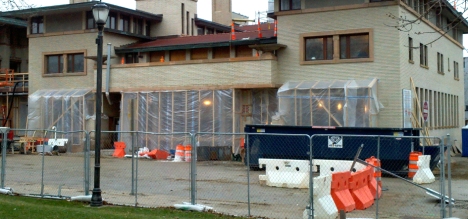I don’t know if Frank Lloyd Wright read Romeo and Juliet or not, but the quote (used as this article’s title) certainly rings true with the importance Wright placed on windows in a building. In his 1943 autobiography Wright wrote, “Glass, this super material, will awaken in us the desire to escape from the prettified cavern of our present domestic life and to see the clear countenance of nature.” Wright’s goal for his personally-designed windows was to form a marriage between the interior of the house and the nature outside.
Wright’s art glass featured abstract natural patterns that combined well with the natural geometry of his homes and commercial structures. While the patterns used in his art glass windows are not specifically identifiable by their natural shape, patterns based on sumac and wisteria are recognizable.
Earlier this spring I wrote a bit about the restoration of Wright’s last remaining hotel, the Park Inn Hotel in Mason City, Iowa. Scheduled to reopen in about a month from now, visitors will be treated to both original Wright-designed windows and new windows based on his designs. A glass restoration expert from nearby Clear Lake, John Larsen, will have restored or remade a total of 62 stained glass windows by the time he is done with his work at the Park Inn Hotel. Seventy-two additional windows for the hotel’s guest rooms were manufactured by Andersen Windows of Minnesota. As can be seen in the accompanying photos, Wright intended to let in a lot of Mother Nature through the many windows that were incorporated in the original design.
One of the greatest stories of the Park Inn restoration project was the discovery of Wright’s original skylight. Removed many years ago during one of the many remodels done has the hotel declined in prominence, the window wound up in a Mason City home. The current owner of the home had always wondered where his beautiful skylight had come from, and when the remodeling of the Park Inn Hotel revealed an old frame the same size has his skylight, the connection was made. He and his wife donated the skylight so that it could once again rest proudly in its original home. Returning the window to its spot on the north side of the Park Inn Hotel was no easy task as it consists of 25 3×3 panels and weighs several hundred pounds. (View image of window)
To see more about the restoration of the Park Inn Hotel, view a movie created by Arian Schuessler. To learn more about Frank Lloyd Wright’s art glass windows, visit the Oakbrook Esser Studios site.

Filed under: 1, Daily Dose of Masonry, Moisture Management, News and Updates | Tagged: architecture, Art Glass, frank lloyd wright, mason city, Park Inn Hotel, Prairie School | Leave a comment »







